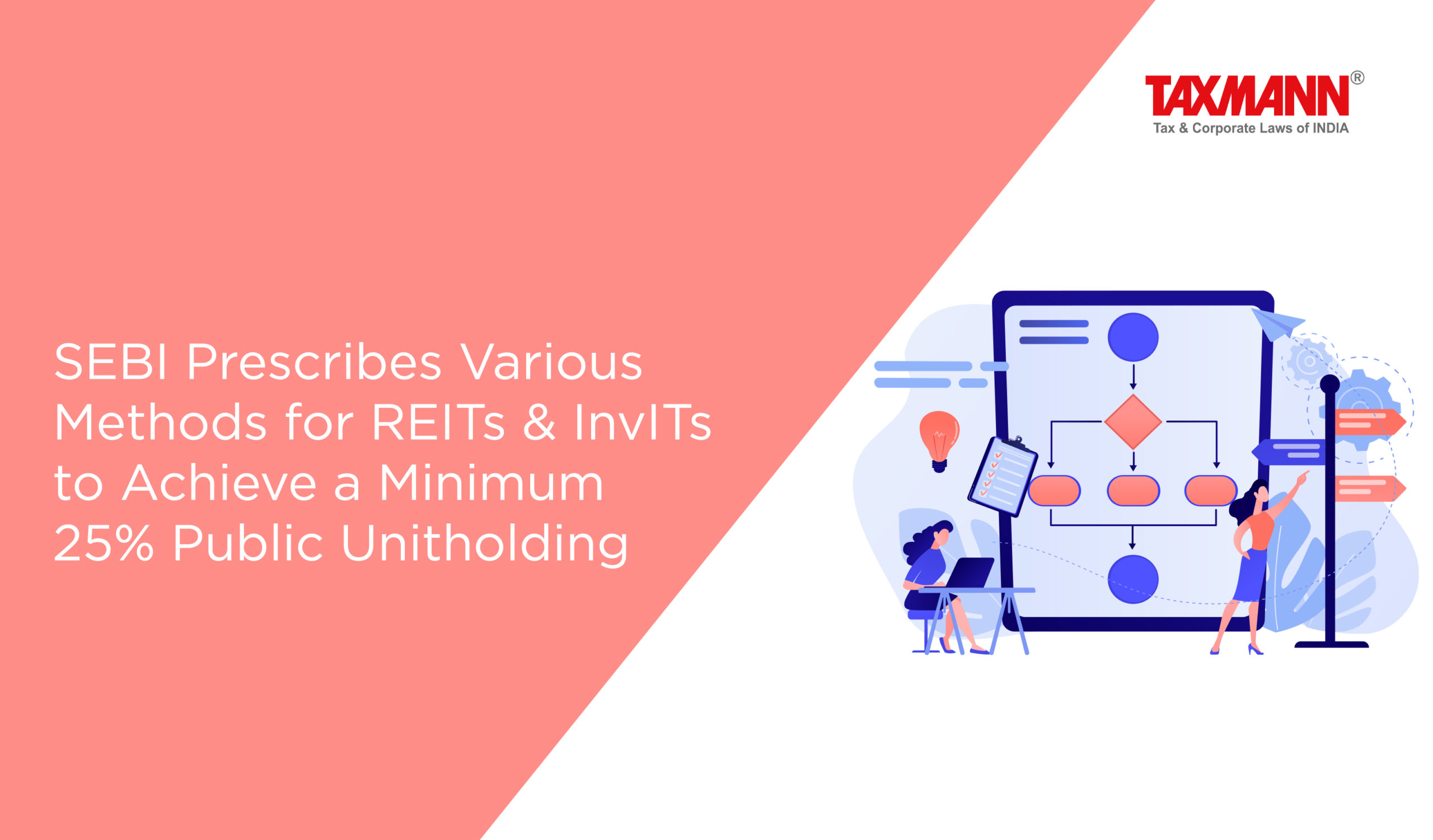SEBI Prescribes Various Methods for REITs & InvITs to Achieve a Minimum 25% Public Unitholding
- Blog|News|Company Law|
- 2 Min Read
- By Taxmann
- |
- Last Updated on 29 June, 2023
Circular No. SEBI/HO/DDHS/PoD2/P/CIR/2023/106 & 107, Dated 27.06.2023
Regulation 14(1A) of SEBI (Infrastructure Investment Trusts) Regulations, 2014 and Regulation 14(2A) of SEBI (Real Estate Investment Trusts) Regulations, 2014 mandates every listed REIT and InvIT which has public unitholding below 25%, shall increase its public unitholding to at least 25% within a period of three years from the date of listing of units pursuant to initial offer.
In order to achieve this, SEBI has prescribed the method of achieving minimum public unitholding of 25% by Real Estate Investment Trusts (REITs) and Infrastructure Investment Trusts (InvITs).
Some of the methods allowed for achieving minimum public unitholding:
1. Public Offer
REITs and InvITs can Issue units to public through issuance of offer document for achieving minimum public unitholding.
2. Offer for sale through issuance of offer document
REITs and InvITs can issue units to public through offer for sale of units held by Sponsor(s)/Manager (Investment manager in case of InvIT)/and their associates/related parties and Sponsor Group.
3. Offer for sale through the stock exchange mechanism
REITs and InvITs can issue units in the secondary market through offer for sale of units held by Sponsor(s)/Manager (Investment manager in case of InvIT)/and their associates/related parties and Sponsor Group through the Stock Exchange mechanism i.e., the secondary market.
4. Rights issue to public unitholders
REITs and InvITs can Issue units to public through right issue subject to the condition that sponsors, managers (Investment managers in case of InvIT), and related parties voluntarily waive their unit entitlements in support of the Issue.
5. Allotment of units under Institutional placement
REITs and InvITs can Issue units to public through making allotment of units under Institutional placement for complying with the requirement of minimum public shareholding.
Click Here To Read The Full Circular
Disclaimer: The content/information published on the website is only for general information of the user and shall not be construed as legal advice. While the Taxmann has exercised reasonable efforts to ensure the veracity of information/content published, Taxmann shall be under no liability in any manner whatsoever for incorrect information, if any.

Taxmann Publications has a dedicated in-house Research & Editorial Team. This team consists of a team of Chartered Accountants, Company Secretaries, and Lawyers. This team works under the guidance and supervision of editor-in-chief Mr Rakesh Bhargava.
The Research and Editorial Team is responsible for developing reliable and accurate content for the readers. The team follows the six-sigma approach to achieve the benchmark of zero error in its publications and research platforms. The team ensures that the following publication guidelines are thoroughly followed while developing the content:
- The statutory material is obtained only from the authorized and reliable sources
- All the latest developments in the judicial and legislative fields are covered
- Prepare the analytical write-ups on current, controversial, and important issues to help the readers to understand the concept and its implications
- Every content published by Taxmann is complete, accurate and lucid
- All evidence-based statements are supported with proper reference to Section, Circular No., Notification No. or citations
- The golden rules of grammar, style and consistency are thoroughly followed
- Font and size that’s easy to read and remain consistent across all imprint and digital publications are applied








 CA | CS | CMA
CA | CS | CMA


